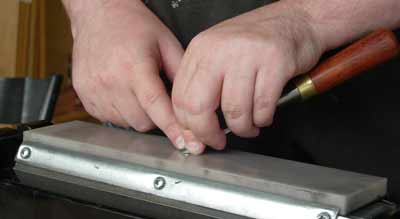If I had a dollar for every post on a woodworking forum about sharpening I'd be a rich man. Really rich - Bill Gates rich.
What I have noticed is that gallons of virtual ink has been spilled on topics like which set of stones to buy, which sharpening jig to buy, etc., but almost nothing about basic sharpening technique and the need to practice. And this to my mind is the problem.
I was taught woodworking by Maurice Fraser. In the first class, after a 40 minute class and a 40 minute hands-on session, Maurice would routinely have a class of brand new students (it was the first class, after all) sharpen a dull chisel to razor sharpness with not much  trouble. To get good at it took practice, but after that first class it wasn't anything anyone thought twice about - except maybe to reread the notes and do some more practicing. You can read about the way he taught it here. A few years ago we did a video for Norton Abrasives and Maurice did the oilstone version and I did the waterstone version. The technique is the same on both versions, just the technology is different. It seems the common feeling these days is that sharpening is something that needs years of practice and only "experts" can do it free hand. THIS SIMPLY ISN'T TRUE. Sharpening was something that you learned really quickly as a first day apprentice or you found another another line of work. Woodworking is about learning dexterity, and training your hands to sharpen is the first step in training your hands to cut straight, chisel to a line, and in general not drop tools on your toe. trouble. To get good at it took practice, but after that first class it wasn't anything anyone thought twice about - except maybe to reread the notes and do some more practicing. You can read about the way he taught it here. A few years ago we did a video for Norton Abrasives and Maurice did the oilstone version and I did the waterstone version. The technique is the same on both versions, just the technology is different. It seems the common feeling these days is that sharpening is something that needs years of practice and only "experts" can do it free hand. THIS SIMPLY ISN'T TRUE. Sharpening was something that you learned really quickly as a first day apprentice or you found another another line of work. Woodworking is about learning dexterity, and training your hands to sharpen is the first step in training your hands to cut straight, chisel to a line, and in general not drop tools on your toe.
I disagree with a lot of teachers in the field. Teachers that I respect a lot - so it bothers me that I disagree with them. A lot of them feel that if they show sharpening using one jig or another, students will get sharp tools right away. They won't be discouraged and will be able to go on to building a project. Maybe there's some truth to this, but I think students would also end up with sharp tools and the ability to progress if they were instructed that free hand sharpening was a basic skill they could master. They'd be able to trust their hands for more and more complicated work earlier on.
And if you don't believe me, take a look at some early woodworking and woodcarving books. Beginner projects were far more involved in days past, and honing guides weren't really on the market in the 19th century. And by the way, if anyone tells you that the people back then weren't as efficient sharpening as we are now with some guide, tell them to look at the furniture made back then. I think the tools were plenty sharp enough.
So here's my idea - drop by our new showroom with a chisel. If I can't teach you to sharpen it properly, I'll give you a free honing guide. (I do reserve the right to grind the chisel initially to a nice hollow grind first.)
Hopefully you'll see that you don't need the guide.
PS - Sharpening videos are currently not available |
 Joel's Blog
Joel's Blog Built-It Blog
Built-It Blog Video Roundup
Video Roundup Classes & Events
Classes & Events Work Magazine
Work Magazine



















 trouble. To get good at it took practice, but after that first class it wasn't anything anyone thought twice about - except maybe to reread the notes and do some more practicing. You can read about the way he taught it
trouble. To get good at it took practice, but after that first class it wasn't anything anyone thought twice about - except maybe to reread the notes and do some more practicing. You can read about the way he taught it
Finally someone who is sure enough of their beliefs that you are willing to put their money where there mouth is. I don't think that you'll have many takers even if you never left the city. I'm a native Brooklynite and I think that you are in an ideal spot that is easily accessible to all those sharpening experts out there.
I hope that I can get healthy enough to visit soon.
Good luck,
Michael Rogen
Nice blog post.
My question for you has to do with the initial grinding that you do, for a hollow
bevel. Do you use a jig for that or do you do it freehand?
-Andy
I have a 6" high speed grinder that I have had for 30 years. I used to use a jig to hold tools to grind and it was a nerve-wracking, horrible experience and I would burn tools. Then, about 4 years ago I upgraded to a proper wheel (We worked with Norton on the development of the 3X wheels) and at the same time Barry Iles taught me how to grind properly.
Now it's a no-brainer - totally free hand - I can easily grind almost anything in a minute or so from walking up to the grinder to walking away with a perfect wire edge from the grind. With no danger to the tool. I wrote an article on the subject which will be published soon - so I can't go into detail just now.
To use or not to use a sharpening jig that is the question? If you can sharpen your tools free hand great, if you can not use a jig. It�s just that simple. The important part is, getting your tools sharp & keeping them sharp. The means & methods are arbitrary & up to the individual.
1. Understand the principals of sharpening.
2. Develop your process.
a. Know what to work on first
b. Know when to move on
c. Know when to stop
d. Be consistence in your approach
We have to remember that most of us are not on the book any longer, so if it takes that extra minute or two to get the edge you require, take it.
After forty six years on the bench I have learned that the real secret to woodworking is sharp tools irrespective of method or means.
Your friend,
Mike
Sorry I can't agree. I've never met anyone who couldn't learn with a little instruction on good technique and dexterity is so important to using hand tools that sharpening is a basic skill like a musician learning scales. Obviously for someone using power tools all the time and hand tools only occasionally the requirements of skill are different but for hand tool usage, which is the core of our business, developing dexterity is everything and free hand sharpening is a really easy way to help that skill develop. Speed and consistency of result are just a bonus.
Are you stating that a craftsman who works with power tools is less of a craftsman than one who works with hand tools? The full time woodworkers that I know who make their living doing this are equally adept in both genres. It would be naive to assume that one was more skilled than the other.
Please clarify.
not at all. However if you use power tools all the time the need and the chances of developing hand skills are smaller. I don't know any modern craftsman - many extremely skilled in modern tool usage, who are nearly as adept at using hand tools as 18th century production data tells us people used to be. And it makes sense - if you spend your career with say a power saw you will never learn to use a handsaw with the efficiency and accuracy and speed of someone who never uses a power saw. It's just practice. And it's true for everything. A network engineer used to working on Unix will have a longer time fixing a Windows PC than an engineer who only works on Windows. Practice makes perfect.
To help develop hand skills faster, free hand sharpening is a simple, practical way to do this.
As a separate point if 18th century craftsman had power tools they would have used them and their speed at hand tool usage would have suffered. When you look at 18th century production records you find that standard production rates for 18th century furniture was FASTER than modern production rates for identical furniture even WITH POWER TOOLS.
The use of hand and power tools both require skill and dexterity. Relying upon one does not necessarilly mean that you are not skilled in the other. I work with people who can make a shaper 'sing' to create a complicated molding and then take that molding and do some handwork on it and then install it (scribing, coping, etc.) solely with hand tools and do a superb job. The majority of today's craftsmen will use whatever is in their arsenal to get the job done. And they should. A power tool requires someone who knows what they are doing to do the job correctly as does a hand tool.
Re: production rates. I find it hard to believe that an 18th cent. worker would work more quickly than a 21st cent. peer who has the advantage of more sophisticated equip. and tooling available.
Lastly, I free-hand sharpen my edge tools. That is how I learned. But I in no way believe that the ability to sharpen means that hand skills will follow. I once believed that hand tools were the 'pure' way to do woodworking. I invested tens of thousands of dollars in fine woodworking tools. Then I started to work professionally in this business. I discovered that the restored tool, while fun to use and to hold, was not always the best choice. This is my point. The knowledgeable craftsperson, will choose to use the tool best suited for the job with no prejudice. To survive in this business, you have to use your head also.
My point is on easy ways to develop skill, not if one skill is better than the other. (for example spraying a finish has got to be a harder skill than using a brush and watching a master finisher spray something is like watching a ballet).
As for production rates. I found it hard to believe too but the data is there. I will write a blog entry on the subject at some point but it's really amazing how fast those guys worked. Of course you must remember that in those days training to get to production speed took a lot longer and people started when they were 14 years old.